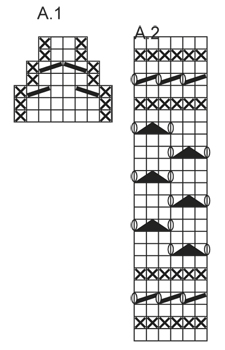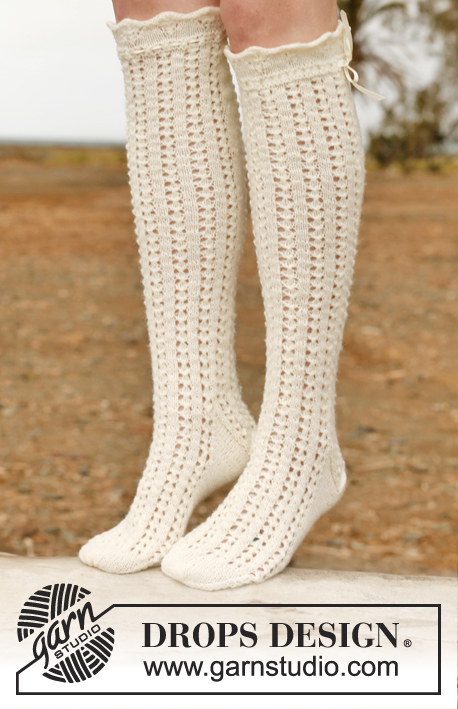Comments / Questions (36)
![]() Siren Camilla Jonsgar wrote:
Siren Camilla Jonsgar wrote:
Når jeg skal begynne helfelling, skal jeg sette merke. Hvor settes dette merket? I begynnelsen av pinnen for helfelling eller midt bak, altså 13 m inn på første pinne på helfellingen?
01.03.2025 - 13:05DROPS Design answered:
Hei Siren, Du setter merket i midten av pinnen (midt bak). Merket brukes til å måle foten med videre. God fornøyelse!
03.03.2025 - 06:48
![]() FARIDA DUBREUIL wrote:
FARIDA DUBREUIL wrote:
Bonjour, J'ai un problème après le diagramme A1 il ne me reste que 42 m au lieu de 48... je l'ai refais deux fois et même résultat. pouvez-vous m'éclairer s'il vous plaît ? Merci de votre retour
14.05.2024 - 13:55DROPS Design answered:
Bonjour Mme Dubreuil, vous devez répéter 12 fois les 8 mailles de A.1 tout le tour (soit 12 x 8 = 96 m), et diminuer 4 mailles dans chaque A.1 de sorte qu'il ne reste que 4 mailles dans chaque A.1 x 12 motifs tout le tour = 48 mailles. Bon tricot!
14.05.2024 - 15:56
![]() Marit wrote:
Marit wrote:
Kosesokker Chrystal med Karismagarn. Da lurer eg på om mønster A skal begynne med 1 vrang 6 rette og så 2 vrange. derfor eg spør er fordi eg ikkje får det til å stemme.
02.02.2022 - 14:03DROPS Design answered:
Hei Marit, Ja, du begynner med 1 vrang og deretter 6 rett , 2 vrang og avslutter omgangen med 6 rett og 1 vrang (96/8 = 12 så du får 12 rapporter av A.1 på omgangen). God fornøyelse!
03.02.2022 - 07:26
![]() Ferial wrote:
Ferial wrote:
Allo encore moi...désolée...les mailles relevés sur les côtés...chez moi j ai du les relever a l envers...est ce ok?
06.01.2022 - 22:20DROPS Design answered:
Bonjour Mme Ferial, je ne suis pas certaine de ce que vous entendeze par "à l'envers", cette vidéo montre à partir du time code 6:05 environ comment on va relever les mailles à gauche du talon. En espérant que cela puisse vous aider. Bon tricot!
07.01.2022 - 07:24
![]() Ferial AITAMEUR wrote:
Ferial AITAMEUR wrote:
Bonjour et bonne fete..je suis bloquée sur le diag A2....car en commencant le A2..j ai 12 mailles sur chaque aiguille mais apres le 4 ieme rand du A2...il me reste 11 mailles dur chaque aiguille....et fonc en arrivant au 8 ieme rand de A2 ( le jeté puis 1m glissé ;2m ensemble ;m glissé au dessus de maille tricoté)..je tricote 3m a l end...et quand je recommence (sur la meme aiguille)..il me reste juste 2 m a la fin...(donc 11 m)....je suis perdue....merci de l aide....
28.12.2021 - 06:45DROPS Design answered:
Bonjour Madame, dans le diagramme A.2 le nombre de mailles ne change pas. Si vous avez moin de mailles, cela signifie, que vous avez peut-etre perdu un/des jetes dans la transition entre les aiguilles double pointes. Bon tricot!
28.12.2021 - 09:02
![]() Linda wrote:
Linda wrote:
Tere. Mustris on viga pärast kanna kudumist (peab olema "jalapealse 20-22-24"): Koo parempidises koes ringselt, SAMAL AJAL kahanda mõlemal küljel järgmiselt: koo pr kokku esimesed 2 silmust pärast jalapealse 44-48-52 silmuseid ja koo pr keerdsilmustena kokku 2 viimast silmuse enne jalapealse 20-22-24 silmust.
28.03.2021 - 18:51
![]() IRENE LUIRO wrote:
IRENE LUIRO wrote:
Miksi ei silmukkaluvut täsmää, ohjeen kanssa, onko ohjeessa virhe, teen sukkaa jossa alussa 96silmukkaa
28.10.2019 - 08:02DROPS Design answered:
Hei, tarkistin ohjeen, mutta en löytänyt virhettä. Piirroksen A.1 mallineuleen aikana työstä kavennetaan yhteensä 48 silmukkaa: 96 - 48 = 48.
17.12.2019 - 17:21
![]() Sophie Trahan wrote:
Sophie Trahan wrote:
Do we work pattern A1 from bottom up or top down?
16.12.2015 - 22:36DROPS Design answered:
Dear Mrs Trahan, diagrams are read from bottom up starting at the bottom corner on the right side towards the left on every round - read more about diagrams here. Happy knitting!
17.12.2015 - 10:28
![]() Kemmers Mireille wrote:
Kemmers Mireille wrote:
Superbe modèle, très bien explqué
16.02.2015 - 12:24
![]() Andi wrote:
Andi wrote:
Dieses Modell habe ich bereits mit 2 verschiedenen Wollsorten gestrickt (flauschige und glatte Wolle) und beide Paare sehen toll aus! Allerdings habe ich auch jeweils die Fersen nach 'meinem' Muster gestrickt ;-)
29.01.2015 - 16:28
Chrystal#chrystalsocks |
|||||||||||||||||||
|
|
|||||||||||||||||||
Knitted DROPS socks with lace pattern in ”Karisma”. Size 35 - 43.
DROPS 146-38 |
|||||||||||||||||||
|
PATTERN: See diagrams A.1 and A.2. DECREASE TIP: Dec as follows before marker: K 2 tog. Dec as follows after marker: Slip 1 st as if to K, K 1, psso. HEEL DECREASE: Row 1 (= RS): Work until 8-9-9 sts remain, slip next st as if to K, K 1, psso, turn piece. Row 2 (= WS): Work until 8-9-9 sts remain, slip next st as if to P, P 1, psso, turn piece. Row 3 (= RS): Work until 7-8-8 sts remain, slip next st as if to K, K 1, psso, turn piece. Row 4 (= WS): Work until 7-8-8 sts remain, slip next st as if to P, P 1, psso, turn piece. Continue dec like this with 1 st less before every dec until there are 10-10-12 sts on needle. ---------------------------------------------------------- ---------------------------------------------------------- SOCK: Worked in the round on double pointed needles. Cast on 96-96-104 sts on double pointed needles size 3.5 mm with Karisma. Work according to A.1. When A.1 has been worked, 48-48-52 sts remain on needle. Continue rib K 2/P 2 for 1 cm, on last round with rib inc 0-0-2 sts evenly = 48-48-54 sts. Then work pattern according to A.2. When A.2 has been worked, work 1 round while dec 4-0-2 sts evenly = 44-48-52 sts. Work 2 cm in stocking st, piece measures approx. 14 cm. Now keep the first 24-26-28 sts on needle for heel and slip the last 20-22-24 sts on a stitch holder (= mid on top of foot). Work in stocking st back and forth on heel sts for 5-5½-6 cm. Insert 1 marker. Then work HEEL DECREASE - see explanation above! After heel dec, knit up 11-12-13 sts along each side of heel and slip the 20-22-24 sts from stitch holder back on needle = 52-56-62 sts. Continue to work in stocking st in the round while AT THE SAME TIME dec in each side as follows: K tog the first 2 sts after the 20-22-24 sts on top of foot and K twisted tog the last 2 sts before the 20-22-24 sts on top foot (i.e. work in back loop of sts instead of front). Repeat dec every other round 3-3-4 more times (4-4-5 dec in total) = 44-48-52 sts. Continue until piece measures 18-20-22 cm from marker on heel (= approx. 4-4-5 cm remain). Now insert 1 marker in each side so that there are 22-24-26 sts on top of foot and under foot. Continue in stocking st while AT THE SAME TIME dec for toes on each side of both markers as follows: 3 sts before marker: K 2 tog, K 2 (marker is between these 2 sts), K 2 twisted tog (i.e. work in back loop of sts instead of front). Dec every other round a total of 3-3-4 times and then every round 6-7-7 times in total = 8 sts remain on needle. Cut the thread and pull it through the remaining sts, tighten tog and fasten. Knit another sock. |
|||||||||||||||||||
Diagram explanations |
|||||||||||||||||||
|
|||||||||||||||||||

|
|||||||||||||||||||
Have you finished this pattern?Tag your pictures with #dropspattern #chrystalsocks or submit them to the #dropsfan gallery. Do you need help with this pattern?You'll find 23 tutorial videos, a Comments/Questions area and more by visiting the pattern on garnstudio.com. © 1982-2025 DROPS Design A/S. We reserve all rights. This document, including all its sub-sections, has copyrights. Read more about what you can do with our patterns at the bottom of each pattern on our site. |
|||||||||||||||||||































































Post a comment to pattern DROPS 146-38
We would love to hear what you have to say about this pattern!
If you want to leave a question, please make sure you select the correct category in the form below, to speed up the answering process. Required fields are marked *.